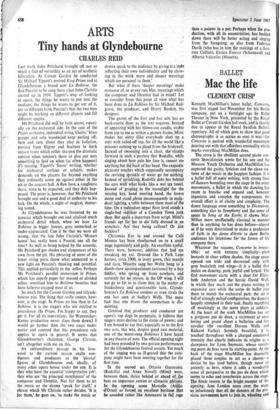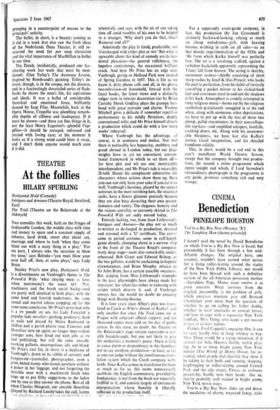Mac :the life.
BALLET
. CLEMENT CRISP Kenneth MacMillan's:latest ballet, Concerto, Was first staged last November for his Berlin company; put on . a 'fortnight ago by Ballet Theater in NeW York, PreSented by the RoYal Ballet at Covent Garden lail week, and is shortly dile to appear ''the `Royal SWedish Ballet's repertory. All of which goes to show that good choreography is as scarce as ever it was—for Concerto is packed with Wonderful movement Pouring out with that effo'rtleis musicality which marks everything MacMillan does.
The score is the ebullient second piano con- certo Shostakoyich wrote for his son and the Moscow Youth Orchestra and MacMillan has captured the gaiety, lyricism and the clean tex- tures of the Music in the .hap,piest fashion. It is a ballet full of open!' writing, With strong lines otdancers bounding over the stage in the outer movements, a ballet in which the dancing has room to breathe and expand and, however ingenious and complex the components, the overall effect is of clarity and simplicity. The dance language owes something to Diversions, something also to SymphottY and the sense of space in Song of the Earth;, it shows 'Mac- Millan more unaffectedly classical in manner than in anything he has done befOre—almost as if he were detertrtined to' make a profession of faith in the danse d'ecOle to show Berlin audiences his intentions for the future of his Company there: Whatever the reasons, Concerto is irresis- tible: set with extreme simplicity—plain leotards 'hi clear yellow shades, the stage space opened out wide and decorated only with grey backcloth and wings—it is a ballet that insists on dancing, pure, joyful and lyrical. The first movement starts with a duet for Eliza- beth Anderton and the 'heroic David Wall, in which they mark out the piano writing in expansive arcs while the corps de ballet join them to match the orchestral part; the air is full of strongly pulsed configuration, the dancers happily stretched in their task, finally marching off mockingly as the score plays at soldiers. At the heart of the work MacMillan has set a gorgeous pas de deux, a statement at once loving and grand about a ballerina and her cavalier (the excellent Doreen Wells and Richard Farley). Serenely beautiful, it is touched throughout with a charged emotional intensity that clearly indicates its origins as a showpiece for Lynn Seymour, whose ravish- ing ports de bras were its starting-point. At the back of the stage MacMillan has discreetly placed three couples to act as a chorus—a device he has used before, though never so potently as here, where it adds a wonderful sense of perspective to the pas de deux which seems to echo and reverberate across the stage. The finale reverts to the bright manlier of the opening; Jane Landon soars over the stage so infectiously that all the dancers of the pre- vious movements have to join in, wheeling and
grouping in a counterpoint of masses to the principals' activity. The ballet, in short, is a beauty; coming as it did in a week that also saw the fresh ideas of the Nederlands Dans Theater, it still re- asserted the -need for. pur -sang classicism and the vital importance of MacMillan to ballet in our time.
The Dutch, incidentally, produced one fas- cinating work last week that must be men- tioned: Glen Tetley's The Anatomy Lesson, inspired by Rembrandt's painting. Tetley's in- terest, though, is in the corpse, not the doctors, and in a fascinatingly dovetailed series of flash- backs he shows the man's life, his aspirations and ideals. It was a ballet of considerable theatrical and emotional force, brilliantly danced by Jaap Flier. Meanwhile, back at the Opera House, CoppJlia was plumbing remark- able depths of silliness and inadequacy. If it must be shown—and there are fine things in it, not the least Henry Legerton's splendid Cop- p6lius—it should be restaged, redressed and treated with loving -care; at the moment it looks as if a strong wind could blow it away, and I don't think anyone would much care if it did.



































 Previous page
Previous page